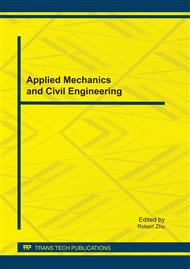[1]
W. X. Liu and H. X. Tang, Sediment quality criteria for heavy metal pollution in the Lean River I. Sediment quality triad approach, Acta Scientiae Circumstantiae, 19 (1999) 120-126. (In Chinese)
Google Scholar
[2]
S. N. Sina, H. Chuaa and W. Lob, Assessment of heavy metal cations in sediments of Shing Mun River, Hong Kong, Environment International, 26 (2001) 297-301.
DOI: 10.1016/s0160-4120(01)00003-4
Google Scholar
[3]
U. Forstner and G. T. Wittmann, Metal pollution in the aquatic environment, Springer-Verleg Press, Berlin, 1979.
Google Scholar
[4]
G. E. Millward and G. A. Glegg, Fluxes and retention of trace metals in the Humber Estuary, Estuarine, Coastal Shelf Science, 44 (1997) 97-105.
DOI: 10.1016/s0272-7714(97)80011-x
Google Scholar
[5]
H. Akcay, A. Oguz and C. Karapire, Study of heavy metal pollution and speciation in Buyak Menderes and Gediz river sediments, Water Research, 37 (2003) 813-822.
DOI: 10.1016/s0043-1354(02)00392-5
Google Scholar
[6]
K. M. Huang and S. Lin, Consequences and implication of heavy metal spatial variations in sediments of the Keelung River drainage basin, Taiwan, Chemosphere, 53 (2003) 1113-1121.
DOI: 10.1016/s0045-6535(03)00592-7
Google Scholar
[7]
J. L. Liu, Y. L. Li, B. Zhang, J. L. Cao, Z. G. Cao and J. Domagalski, Ecological risk of heavy metals in sediments of the Luan River source water, Ecotoxicology, 18 (2009) 748-758.
DOI: 10.1007/s10646-009-0345-y
Google Scholar
[8]
X. C. Liu, B. Zu, X. F. Song, J. Xia, C. Y. Tang and Y. Z. Zhang, Water chemistry and nitrate pollution in the Liangtan River basin in the Three Gorges Reservoir Area, Geographical Research, 29 (2010) 629-639. (In Chinese)
Google Scholar
[9]
E. R. Long, D. D. Macdonald, S. L. Smith and F. D. Calder, Incidence of adverse biological effects within ranges of chemical concentrations in marine and estuarine sediments, Environmental Management, 19 (1995) 81-87.
DOI: 10.1007/bf02472006
Google Scholar
[10]
L. Hakanson, An ecological risk index for aquatic pollution control. A sedimentological approach, Water Research, 14 (1980) 975-1001.
DOI: 10.1016/0043-1354(80)90143-8
Google Scholar
[11]
D.D Macdonald, S. Carr, F. Calder, E. Long and C. Ingersoll, Development and evaluation of sediment quality guidelines for Florida coastal waters. Ecotoxicology, 5 (1996) 253-278.
DOI: 10.1007/bf00118995
Google Scholar
[12]
E. R. Long and D. D. MacDonald, Recommended uses of empirically derived, sediment quality guidelines for marine and estuarine ecosystems, Hum. Ecol. Risk Assess. 4 (1998) 1019-1039.
DOI: 10.1080/10807039891284956
Google Scholar
[13]
D. D. MacDonald, R. S. Carr, D. Eckenrod, H. Greening, S. Grabe, et al., Development, evaluation, and application of sediment quality targets for assessing and managing contaminated sediments in Tampa Bay, Florida, Arch. Environ. Contam. Toxicol. 46 (2004) 147-161.
DOI: 10.1007/s00244-003-2270-z
Google Scholar
[14]
Z. Q. Xu, S. J. Ni, X. G. Tuo and C. J. Zhang, Calculation of heavy metals' toxicity coefficient in the evaluation of potential ecological risk index, Environmental Science & Technology, 31 (2008) 112-115. (In Chinese)
Google Scholar
[15]
C. Liu, Z. Y. Wang, Y. He and Y. S. Wu, Evaluation on the potential ecological risk for the river mouths around Bohai bay, Research of Environmental Sciences, 15 (2002) 33-37. (In Chinese)
Google Scholar
[16]
H.Yu, W. B. Zhang and J. P. Yu, Distribution and potential ecological risk assessment of heavy metals in surface sediments of Hongze Lake, Environmental Science, 32 (2011) 437-444. (In Chinese)
Google Scholar
[17]
J. Tang, Y. P. Zhong and L. Wang, Background value of soil heavy metal in the Three Gorges Reservoir District, Chinese Journal of Eco-Agriculture, 16 (2008) 848-852. (In Chinese)
DOI: 10.3724/sp.j.1011.2008.00848
Google Scholar
[18]
T. Li, Abundance of elements of the earth and crust, Geological Press, Beijing, 1990. (In Chinese)
Google Scholar


